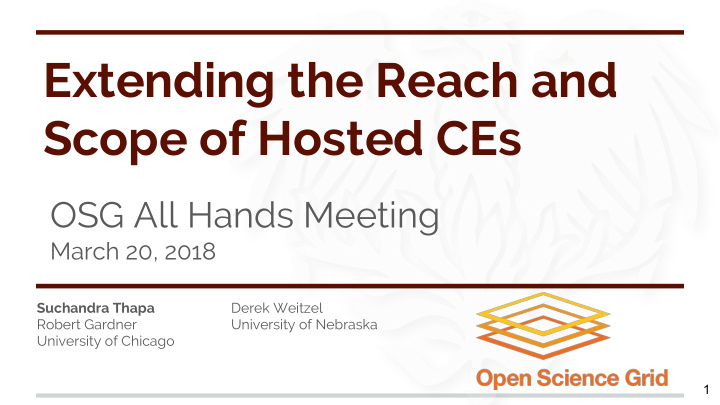



Extending the Reach and Scope of Hosted CEs OSG All Hands Meeting March 20, 2018 Suchandra Thapa Derek Weitzel Robert Gardner University of Nebraska University of Chicago 1
Introduction Hosted Compute Elements (CEs) were introduced about a ● year and a half ago to give sites an easier way to contribute cycles to OSG Sites also get a deeper view on their contributions to OSG ● Since then Hosted CEs have extended the sites and ● resources that can be integrated into OSG ○ Greater geographical reach Sites that differ from the "typical" OSG site ○ HPC resources on XSEDE ○ 2
The Hosted CE Approach ● Using HTCondor Bosco CE (i.e. 'Hosted CE'), the CE administration can be cleanly separated from the cluster administration ● Cluster admins only need to provide ssh access to cluster ● OSG staff can maintain the hosted CE and associated software and deal with OSG user/site support 3
Providing local view of science ● After OSG jobs started running, admins can track their cluster's contributions to OSG users using GRACC ● Multiple views on contributions to OSG users: ○ By field of science ○ By project or VO ○ By researcher's institution 4
CE hosting infrastructure ● Minimal requirements ● Hosted CE can be run on a fairly small VM ( 1 core / 1GB) ○ Memory usage for typical hosted CE is less than 512MB ○ Hosted CE VMs cpu have been more than 80% idle ○ Max network traffic is fairly low (<200Kb/s) 5
Greater Geographical Reach ● Low cost of entry has allowed sites to contribute despite time zone and logistical difficulties ● Example: IUCAA Sarathi (LIGO India) ○ Located in Pune, India ○ 12:30 hour difference ( 1 day lag in email responses) ○ Didn't want to require admins to need to learn about the internal details about OSG glidein infrastructure 6
IUCAA Sarathi Cluster (LIGO - India) LIGO users running under a LIGO specific account through OSG ~80k wall hours provided from India this year! 7
Expanding the variety of sites ● Bulk of sites contributing to OSG tend to be national labs or large research institutions ○ A lot are brought in by ATLAS or CMS ● Due to the lower cost of entry when using hosted CEs, other types of sites can now contribute: University of Utah ○ North Dakota State University ○ Georgia State University ○ ○ Wayne State 8
Example: University of Utah ● Several clusters on campus + ● Time needed to become familiar with OSG CE operations / Glidein troubleshooting = ● Significant barrier to entry in order to contribute to OSG 9
Utah contributions All three clusters brought into production over the last 2 weeks Still tweaking jobs, looking at using multicore jobs to more effectively backfill and get more cores Already contributed ~60k cpu hours, in top 2 institutions contributing through Hosted CEs 10
North Dakota State University Two clusters, CCAST3 was brought online beginning of year Single core jobs on CCAST2, 8 core jobs on CCAST3 670K wall hours delivered, one of top hosted CE sites 11
Georgia State University 194K wall hours delivered since Jan 1 18 Projects helped Provided cpu to 11 fields of science 12 Institutions ran jobs on resource 12
Wayne State University 300k cpu hours delivered since Jan 1 Ran jobs from 24 projects, 13 fields of science, and 14 institutions 13
Total Contributions >1.3M wall hours delivered since Jan 1 Averaging about 111K wall hours a week. About 10-15% of weekly opportunistic usage by OSG Connect users Ran jobs from 25 fields of science and 35 institutions 14
Integrating HPC resources into OSG ● Major cultural differences between HPC resources and OSG resources ○ MultiFactor Authentication (MFA) using tokens ○ Software access and distribution ○ Allocations 15
Bridging the Gap ● Solutions: ○ Authentication -> get MFA exceptions or use IP address as a factor ○ Software access -> Stratum-R ○ Job Routing -> Multi-user BOSCO 16
User Authentication ● HPC resources are increasingly moving to using MFA ○ OSG software doesn't have any way to incorporate token requirements into job authentication ● Solutions: ○ Use submit site's IP as one factor. All job submissions come from a fixed IP. ■ ■ Can use a ssh public key or proxy as another factor Get a MFA exception for accounts ○ ■ Sites often have procedures requesting this for science gateways or similar facilities to use. 17
Software distribution and access ● VOs and users are increasingly using CVMFS to distribute software and data ○ HPC resources usually aren't willing to install and maintain CVMFS on their compute nodes ● Stratum-R allows for replication of selected CVMFS repositories Requires some effort from admins but not much ○ Successfully used on Bluewaters, Stampede, Stampede2 ○ 18
Stratum-R 19
Routing jobs to allocations ● Due to allocations, must route jobs to proper user accounts on HPC resources ● BOSCO's default configuration is to use a single user on remote resource for all job submissions ● With some modifications to config files, JobRouter entries, and other bits, can have jobs going to different users on remote resources ○ This allows for jobs to use different allocations, partitions, configurations 20
HTCondorCE BOSCO Job Routing 21
Running CMS jobs on XSEDE Stampede2 Still validating and testing CMS workflows on Bridges and Stampede2 Bridges 22
Conclusions ● Hosted CEs offer OSG the opportunity to obtain cycles and engage with new types of sites and resources increasing the diversity and reach of OSG. ○ Smaller universities and institutions ○ XSEDE resources (direct allocations for users) 23
More information ● Support document for cluster admins ● BOSCO CE 24
Acknowledgements ● Derek Weitzel Factory Ops (Jeff Dost, Marian Zvada) ● David Lesny ● Mats Rynge ● ● CMS HepCloud Team (Dirk, Ajit, Burt, Steve, Farrukh) Lincoln Bryant - Infrastructure support ● Rob Gardner ● 25
Recommend
More recommend